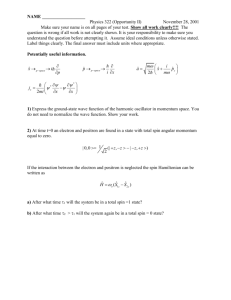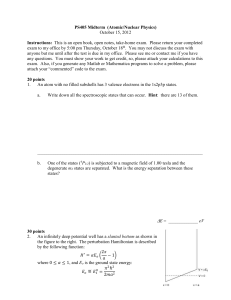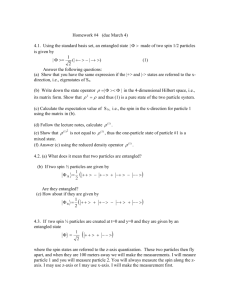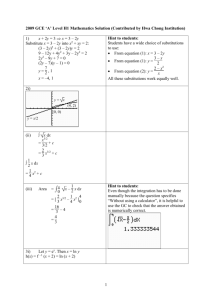Homework of Phys 621-Quantum mechanics I (Fall 2007)
advertisement
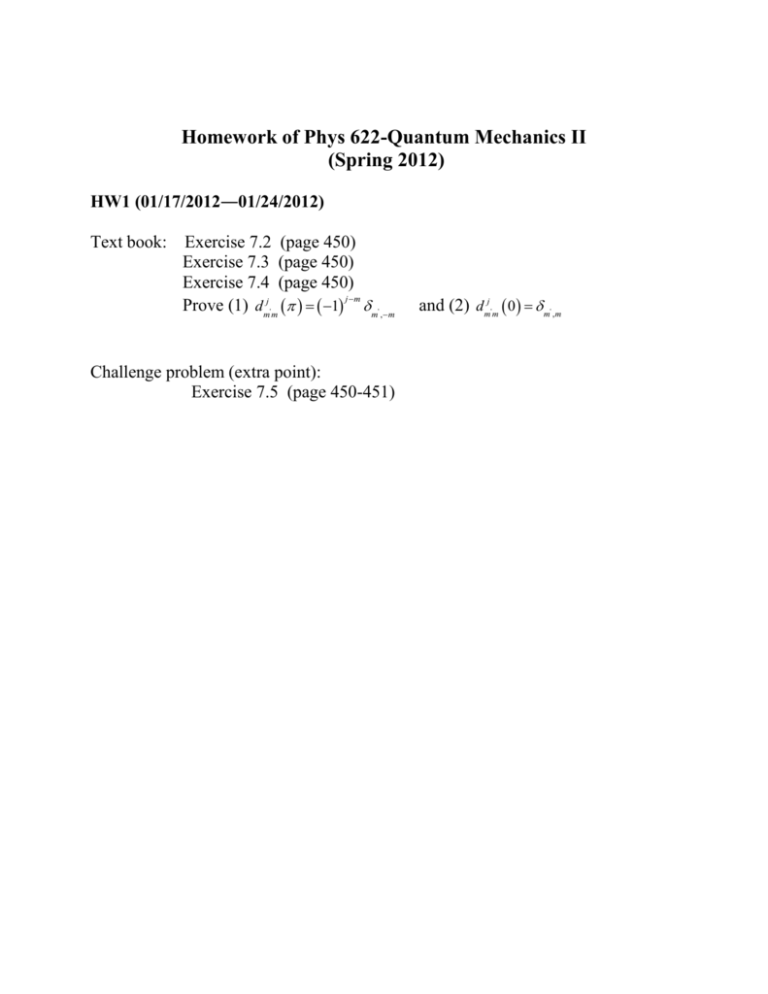
Homework of Phys 622-Quantum Mechanics II (Spring 2012) HW1 (01/17/2012―01/24/2012) Text book: Exercise 7.2 (page 450) Exercise 7.3 (page 450) Exercise 7.4 (page 450) j m Prove (1) dmj m 1 m ,m ' ' Challenge problem (extra point): Exercise 7.5 (page 450-451) and (2) dmj m 0 m ,m ' ' HW2 (01/24/2012―01/31/2012) Text book: Exercise 7.11 (page 452) ˆ A Bˆ Aˆ , Bˆ (Hint: e A Be ˆ ˆ 1 ˆ ˆ ˆ 1 ˆ ˆ ˆ ˆ A, A, B A, A, A, B ... ) 3! 2! Exercise 7.12 (page 452) Exercise 7.19 (page 452) Exercise 7.20 (page 453) Challenge problem (extra point): Exercise 7.13 (page 450-451) HW3 (01/31/2012―02/07/2012) Text book: Use the recursion relation (7.155) and the orthornomalization of the eigenvectors 1 1 (i.e., l , m l , m 1 and 2 2 1 1 l , m l , m 0 ) to prove Eq. (7.203) 2 2 Exercise 7.8 (page 451) (Hint: you can apply the 1 formula j, m j l , m j 2 1 1 l mj 1 1 1 2 l, , m , 2 l, 1 , m 1 , 1 ) j j 2l 1 2 2 2 2l 1 2 2 2 l mj Exercise 7.23 (page 453) Exercise 7.27 (page 454) Challenge problem (extra point): Exercise 7.24 (page 453) HW4 (02/07/2012―02/14/2012) Text book: The total spin of a system of three noninteraction spins 1 ( S1 S2 S3 ) is Sˆ Sˆ1 Sˆ2 Sˆ3 . If we choose Sˆ Sˆ12 Sˆ3 , where Sˆ12 Sˆ1 Sˆ2 , 2 please find the Clebsch-Gordan Coefficients corresponding to the states 1 1 1 1 1 1 1 1 ; 0, , ; 1, , ; 1, , . 2 2 2 2 2 2 2 2 ( S12 , S , ms ): 0, , Exercise 7.29 (page 454) Exercise 7.30 (page 454) Exercise 7.32 (page 454) (Hint: rewrite the Hamiltonina in terms of ˆ ˆ ˆ ˆ ˆ ˆ ˆ ˆ ˆ ˆ ˆ ˆ ˆ S 2 , S132 , S22 , and S z , where S S1 S2 S3 S13 S2 , S13 S1 S3 , ˆ ˆ 1 ˆ ˆ ˆ S13 S 2 S 2 S132 S 22 , and Sˆz Sˆ1z Sˆ2 z Sˆ3 z , respectively) 2 Challenge problem (extra point): Exercise 7.22 (page 453) HW5 (02/14/2012―02/21/2012) Text book: Exercise 8.1 (page 484) (Hint: The bosons in this case are spin 0 particles. Therefore, the spin part of the wave function S ( s1, s2, s3, ) can be ignored in the total wave function.) Exercise 8.2 (page 485) Exercise 8.3 (page 485) (Hint: (1) There is no symmetry restriction on the states of nonidentical particles system. (2) If there is no orbital angular momentum, the total wave function is given by the spin part of the wave function only (i.e., the eigenstates of total angular momentum). (3) You can use the table provided in the class to find the C.G. coefficients.) Exercise 8.4 (page 485) Challenge problem (extra point): Exercise 8.5 (page 485) HW6 (02/21/2012―02/28/2012) Text book: Exercise 8.7 (page 485) Exercise 8.9 (page 485) (ignoring spin) Exercise 8.12 (page 486) Supose you had three (noninteractiong) identical particles, in thermal equilibrium, in a one-dimensional harmonic oscillator potential, with a total energy E 9 . (a) If they are distinguishable particles, what are the possible occupation2 number configuration, and how many distinc (three-particle) states are there for each one? What is the most probable configuration? (b) Do the same for the case of identical fermons (ignoring spin). (c) Do the same for the case of identical bosons (ignoring spin). Challenge problem (extra point): Exercise 8.14 (page 486) HW7 (02/28/2012―03/06/2012) Text book: Exercise 8.18 (page 487) Exercise 8.19 (page 487) Exercise 9.3 (page 562) Exercise 9.4 (page 562) (Hint: 1 x 1 x ) Challenge problem (extra point): Exercise 9.7 (page 563) (Hint: (1) apply the symmetry of the intergrand for intergrals (2) apply xˆ calculations) 2m aˆ x aˆ x† yˆ 2m aˆ y aˆ †y , for non-zero intergral HW8 (03/20/2012―03/27/2012) Text book: Exercise 9.5 (page 562) Exercise 9.13 (page 564) Exercise 9.39 (page 568) Exercise 9.44 (page 569) Challenge problem (extra point): Exercise 9.41 (page 568) HW9 (03/27/2012―04/03/2012) Text book: Exercise 9.23 (page 566) Exercise 9.27 (page 566) Exercise 10.2 (page 613) ˆ A Bˆ Aˆ , Bˆ (Hint: e A Be ˆ ˆ 1 ˆ ˆ ˆ 1 ˆ ˆ ˆ ˆ A, A, B A, A, A, B ... ) 3! 2! Exercise 10.5 (page 614) Challenge problem (extra point): Exercise 9.20 (page 565) HW10 (04/03/2012―04/10/2012) Text book: Exercise 10.9 (page 614) Exercise 10.10 (page 614) Exercise 10.12 (page 615) Exercise 10.15 (page 615) Challenge problem (extra point): Exercise 10.20 (page 616) HW11 (04/10/2012―04/19/2012) Text book: Exercise 11.1 (page 650) Exercise 11.3 (page 650) Exercise 11.4 (page 650) Exercise 11.5 (page 650) Challenge problem (extra point): Exercise 11.2 (page 650)


